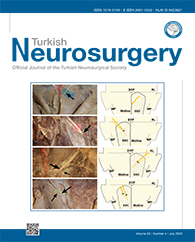MATERIAL and METHODS: Data of one hundred and eleven patients who underwent TLIF were retrospectively reviewed. The inclusion criteria were preoperative radiculopathy and presence of neurological deterioration without previous surgery. Improved MEP amplitudes reaching the baseline MEP amplitudes of the contralateral side at the same level were used as the thresholds for determining the final disc height and cage size during surgery. Cage size, disc heights of the three areas, foraminal area, and global spinal and local balance were measured.
RESULTS: Twenty-two patients (3 male and 19 female) with a mean age of 61.9 ± 8.9 years were included into the study. The mean height of cages was 10.3 ± 1.4 mm (range, 8?14 mm). The mean improvement in MEP amplitude was 27 ± 11% (range, 15?50%). The anterior, middle, and posterior disc heights improved to 2 ± 1.6, 2.7 ± 1.7, and 1.7 ± 1.3 mm, respectively. The improvement in the middle disc height was significantly greater (p<0.05). Segmental lordosis improved from 16.2° ± 10.7° to 19.4° ± 9.2°. Additionally, lumbar lordosis improved from 46.7° ± 14.6° to 51.2° ± 11.2° (p < 0.05). Cage height or improvements in disc height was not correlated with MEP changes. However, there was a positive correlation between ipsilateral foraminal area restoration and MEP changes (r=0.501; p<0.01).
CONCLUSION: Improved MEP amplitudes reaching the baseline MEP amplitudes of the contralateral side of the same spinal level might be a useful threshold for determining the final minimum disc height during TLIF surgery with satisfactory postoperative radiological results, including sagittal and segmental radiological parameters.
Keywords : Transforaminal lumbar interbody fusion, Lumbar vertebrae, Spinal foramen, Intraoperative neurophysiological monitoring, Motor-evoked potentials




